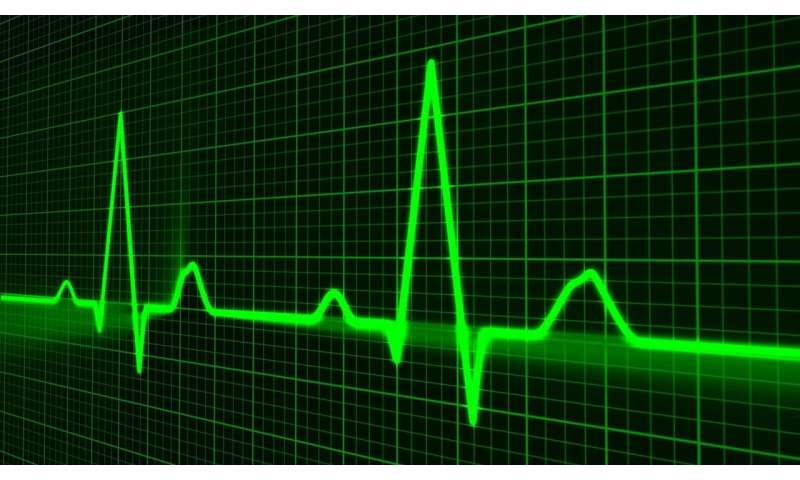
The heart can stably maintain blood flow—at rest or under stress—over a lifetime. Using a mouse model, an LMU team has now uncovered the role played by a specific class of ion channels in controlling the heart rate.
Over the course of an average lifetime, the human heart generates on the order of three billion beats—without interruption and with remarkable precision. This feature is made possible by a comparatively small region that lies within the right ventricle and is known as the sinoatrial node. It can be thought of as the pendulum that keeps the heart ticking.
It is now known that the sinoatrial node is made up of a group of specialized heart muscle cells. Together, these ‘myocytes’ generate the electrical oscillations that regulate the rhythmical contractions of the heart. In healthy adults, the heartbeat varies in frequency between 60 and 80 cycles per minute.
Under appropriate conditions, an isolated heart will continue to beat at a constant rate. “In the body, of course, the heartrate must be regulated in accordance with the activities of its host,” says Dr. Stefanie Fenske, leader of an independent research group at the Institute of Pharmacology (Director: Prof. Dr. Martin Biel) in the Department of Pharmacy at LMU Munich. “This task is carried out by the autonomic nervous system, which is composed of two subsystems known as the sympathetic and parasympathetic branches,” she adds. In addition to acting upon many other physiological systems, they provide the innervation that controls the activity of sinoatrial node of the heart.
How then does this regulation of the heart rate work? For decades, researchers have suspected that specialized ion channels in the cells of the sinoatrial node are involved in the process. Ion channels are proteins that are embedded in biological membranes and regulate the passage of electrically charged atoms across them. These proteins therefore play an indispensable role in the generation of nerve impulses and muscle contractions. The ion channels thought to control the heartbeat are called ‘hyperpolarization-activated cyclic nucleotide-gated cation channels’ – or ‘HCN channels’ for short. The cells of the sinoatrial node possess three subtypes of these channels HCN1, HCN2 and HCN4. As the name implies, HCN channels are activated by a change in the voltage across the cell membrane (hyperpolarization) and a signal molecule called cyclic adenosine monophosphate (cAMP, a cyclic nucleotide), which is synthesized in the cells of the sinoatrial node in response to input from the sympathetic nervous system, increases their activity. According to the conventional theory, when cAMP acts upon the HCN4 channel, the result is an increase in the heart rate.
Although this model of the role of HCN channels seems plausible, it has proven difficult to verify in biological systems, and experiments in different model systems have provided conflicting results. Studies using genetically mutated HCN channels which are linked to defects in heart function in humans had also failed to clarify the issue.
A new mouse model
“To shed further light on the problem, Martin Biel’s group developed a new genetic mouse model. In this mouse strain, the HCN4 channel no longer responds to input from the autonomic nervous system,” Fenske explains. More specifically, the gene that codes for the HCN4 channel was mutated in such a way that the ion channel is unable to bind cAMP. The mutant mice were found to exhibit cardiac arrhythmias, characterized by the heart rate being too lowand additionally the heartbeat was very irregular. These symptoms are typical of the condition known as the ‘sick sinus syndrome’ in humans. However, in spite of these pathologies, the mutant mice were still capable of regulating the heart’s contraction rate, in spite of the fact that their HCN4 channels are unable to bind cAMP.
“So the hypothesis presented in every physiology and pharmacology textbook in relation to the significance of this ion channel in the regulation of the heartrate is incorrect,” Fenske concludes. “What then is the real function of this channel in the heart?” Her experiments showed that HCN4 stabilizes the heart rhythm by dampening overshooting reactions to the activity of the sympathetic and parasympathetic systems—an eminently important task. By monitoring the electrical activity of single cells in the sinoatrial node, Fenske and colleagues discovered that they often remain inactive for periods of up to a minute, and that this property makes a significant contribution to the regulation of the heart rate. In these studies, the team in Munich has cooperated closely with the research group led by Prof. Dr. Christian Wahl-Schott’s at the Medical University of Hannover, who provided important tools and expertise for the analysis of the mouse model system.
Source: Read Full Article
